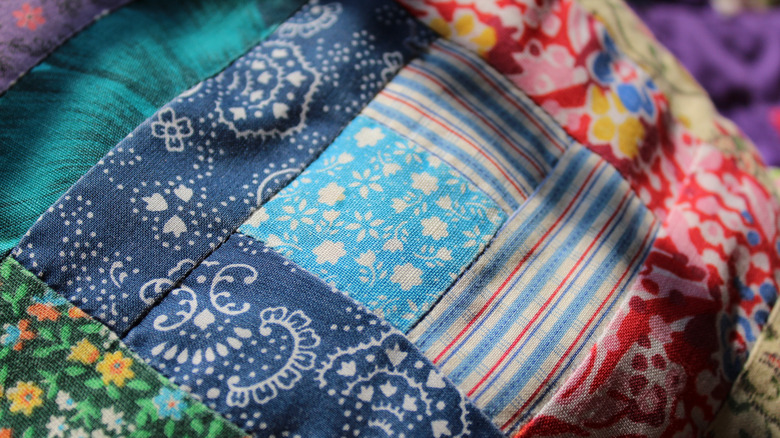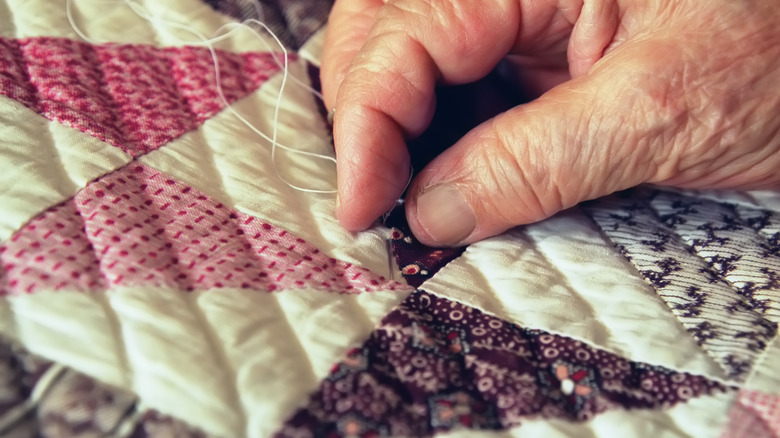The Best Way To Clean A Quilt
When it comes to cleaning a wide variety of household items while minimizing hassle, most homeowners find their washing machine to be an absolute godsend. However, if you're about to throw an heirloom quilt into the washing machine, you might be at risk of destroying your great-grandmother's creation. According to the National Quilters Circle, it's basically impossible to clean your quilt without causing some degree of damage, so cleaning it the right way is imperative if you want your quilts to last as long as possible.
Although most modern cleaning methods have the potential to damage delicate quilts (per MyDomaine), some homeowners will find success cleaning their favorite quilt in the washing machine. However, anyone who opts to machine-wash their quilt will need to be incredibly careful in order to prevent damaging or destroying their quilt. That being said, if you're at all worried about causing damage to your quilt when attempting to clean it, the best method is spot cleaning or gentle hand-washing. Of course, even these methods require a careful hand and a bit of forethought in order to protect your quilt from becoming damaged or unusable.
Gently washing delicate quilts
There are two primary methods for gently cleaning a quilt at home: handwashing and spot cleaning. When handwashing your quilt, special care should be given to the detergent you use since harsh detergents can damage the quilt. According to MyDomaine, you should avoid detergents that use bleach, dyes, or fragrances, just to be safe. You'll also need a large, clean area to wash the quilt, such as a clean bathtub. When handwashing your quilt in the tub, you'll want to be sure to avoid agitating the quilt too roughly. You can then wash the quilt with a mixture of fresh water and a little bit of vinegar before rinsing and air drying the quilt (per Casper). Using a pinch of vinegar helps keep detergent residue off of your quilt after it's rinsed, which can help prolong its life.
Spot cleaning a quilt is somewhat easier than hand washing, but it's not without risk. As such, it's wise to test the fabric where you'll be spot cleaning for color fastness. If the color bleeds onto a moist cotton swab when pressed against it, you might want to consider taking your quilt to a professional cleaner. Otherwise, you are free to dab the affected area with a mild quilt soap mixed with distilled water. Just be sure not to rub the stain, as this can cause damage and is unlikely to remove it (per National Quilters Circle).
Machine-washing your quilts
Although machine-washing your quilts isn't generally recommended by experts, it's still possible to safely and effectively wash your quilt in the washing machine without ruining it. However, you'll still want to adhere to some safety guidelines in order to protect your quilt. First, machine-washing is particularly risky for old, handmade quilts. So, if you need to clean a quilt that's been in your family for generations, it might be a good idea to hand wash or spot clean it instead of using the washing machine (per MyDomaine). Also, as with hand-washing quilts, you'll want to use an exceptionally gentle detergent, such as those specifically made for cleaning quilts.
Now that we've got that out of the way, the actual process for machine-washing a quilt is fairly straightforward. Simply wash the quilt on your machine's coldest setting and choose a cycle made for delicate textiles if possible. Once your quilt is finished being washed, it should be hung to dry. Also, before throwing your favorite quilt into your washing machine, be sure that your machine has the capacity to get the job done.


